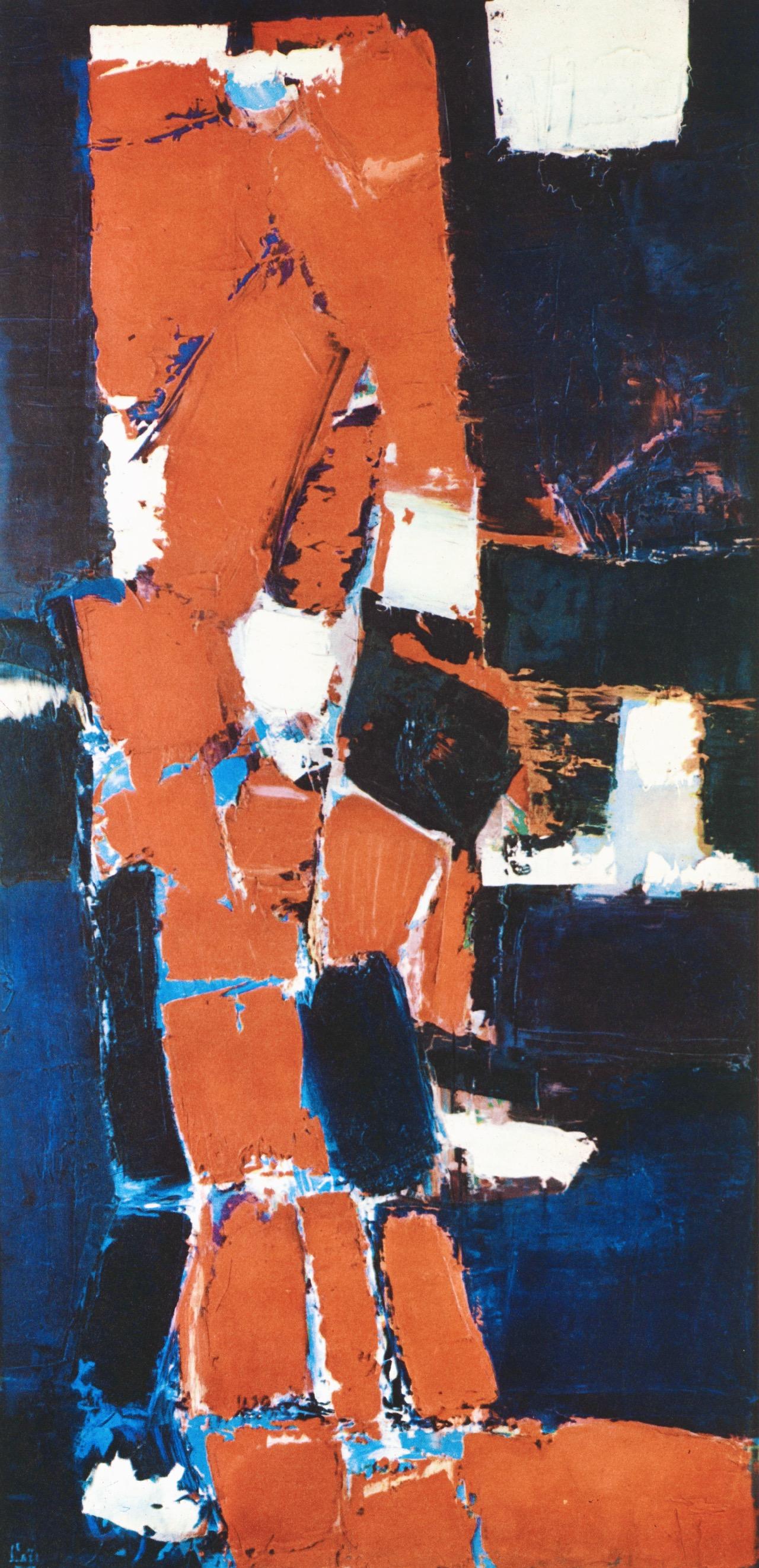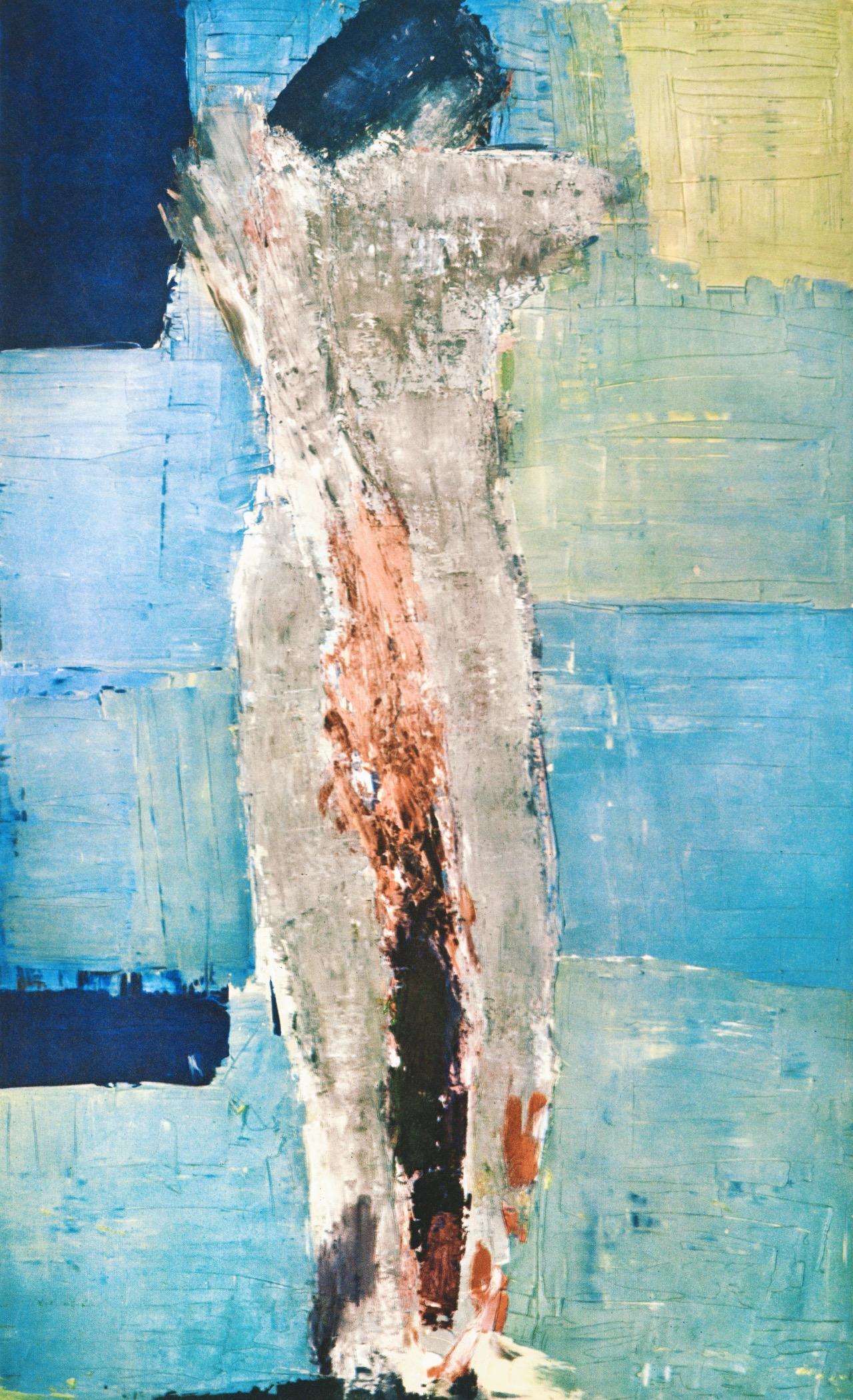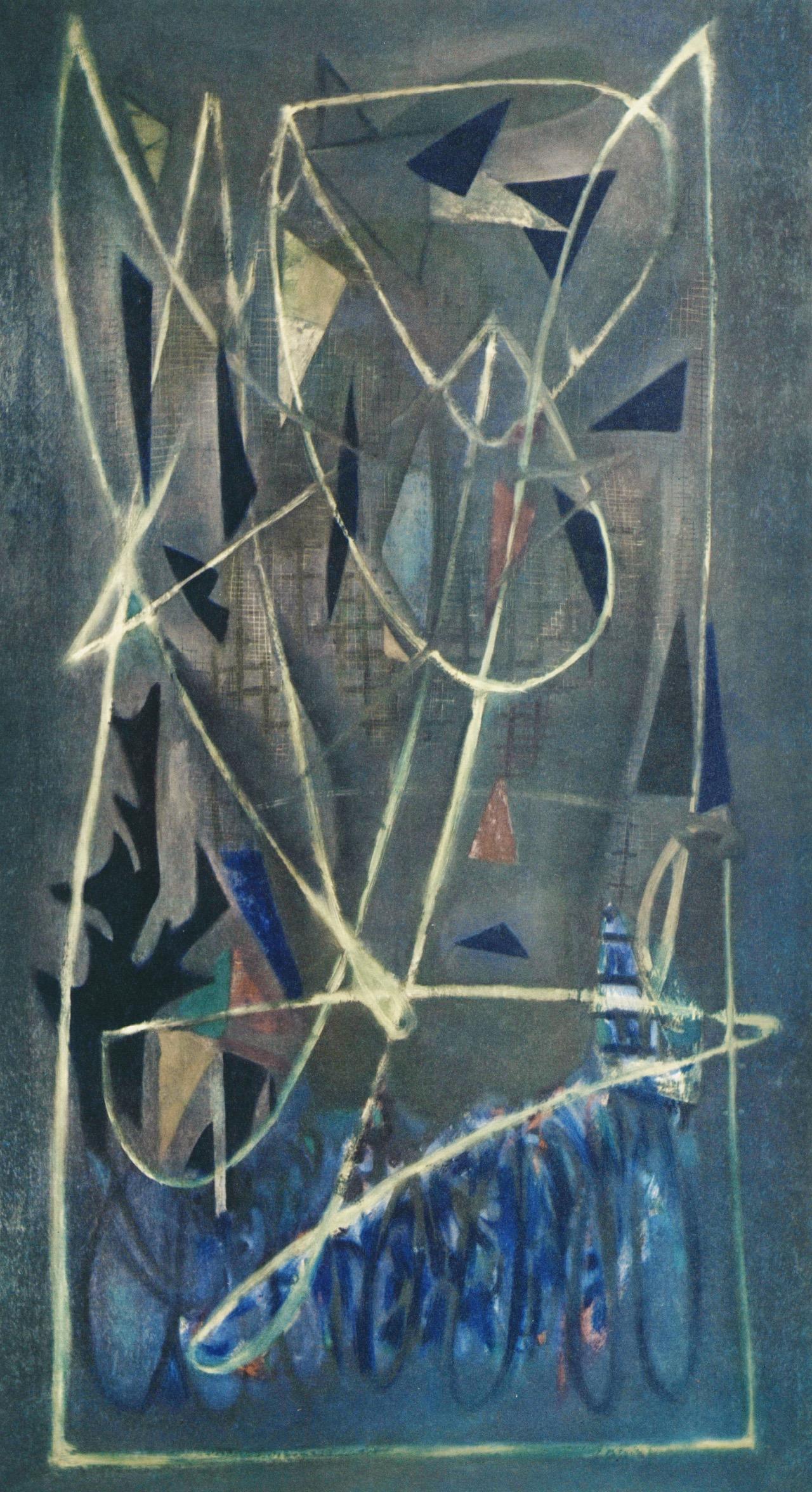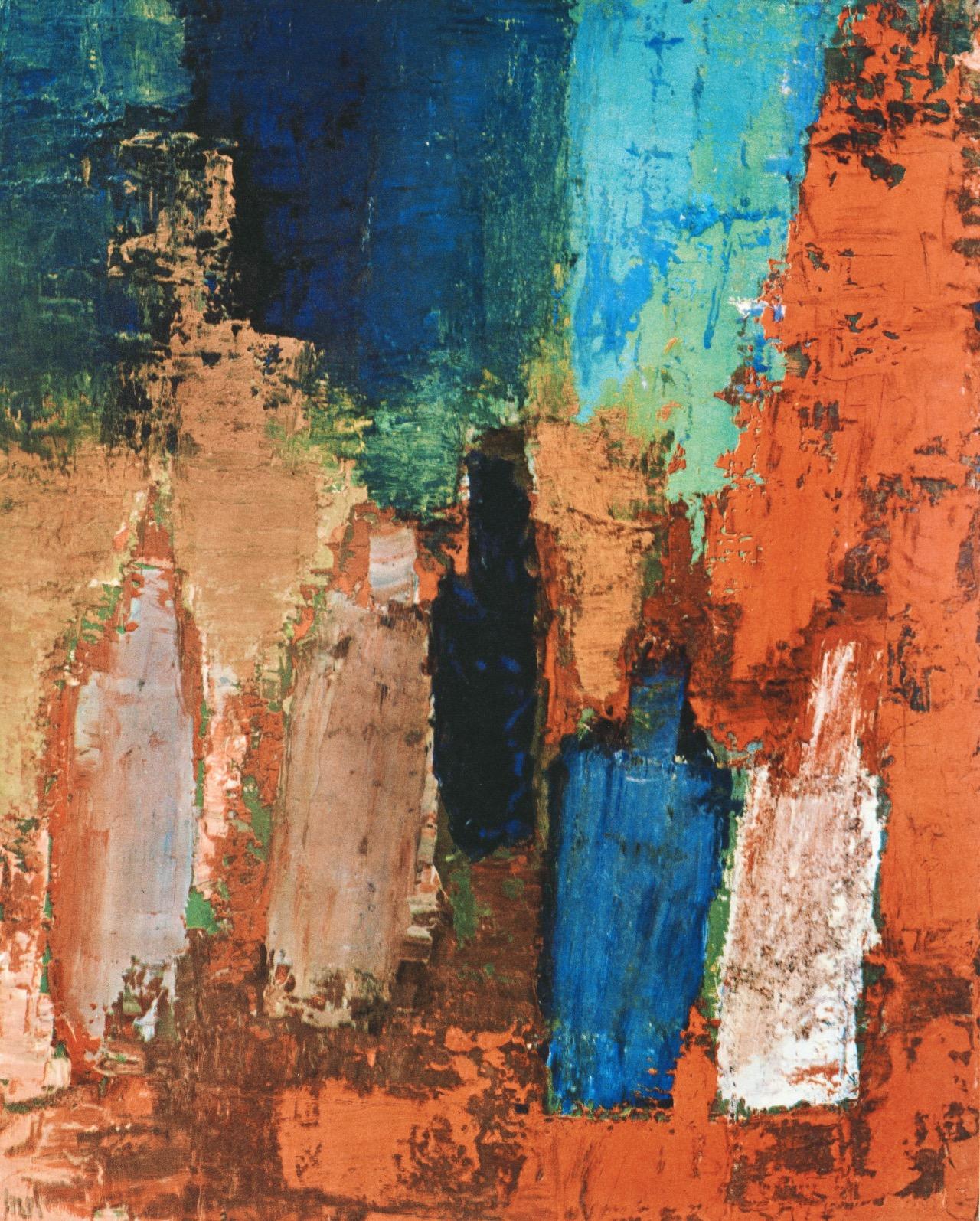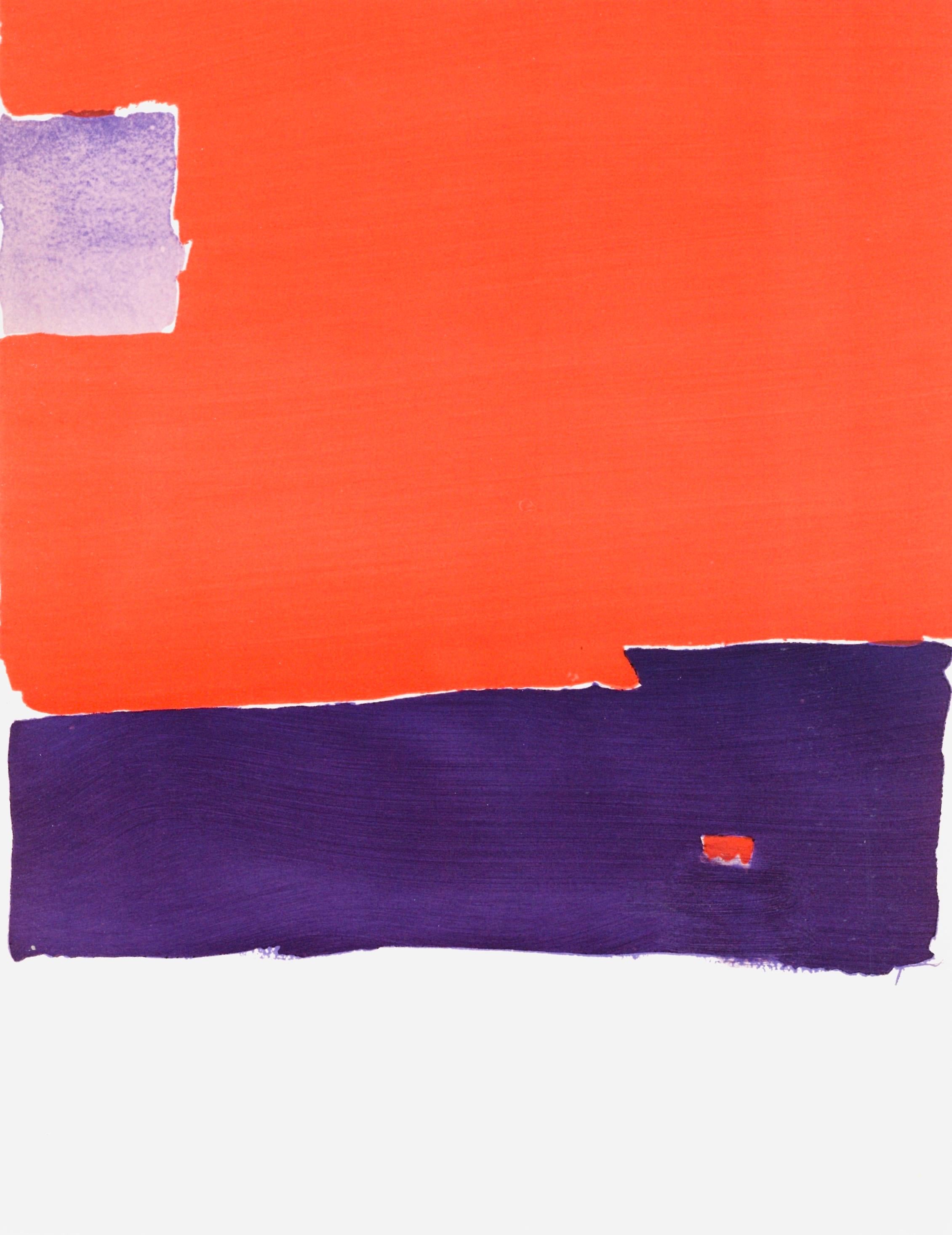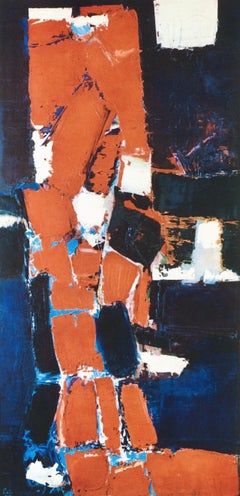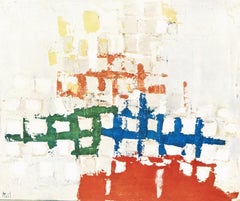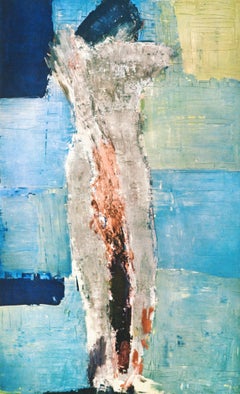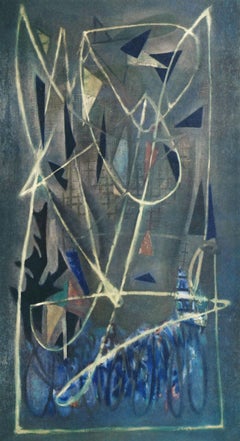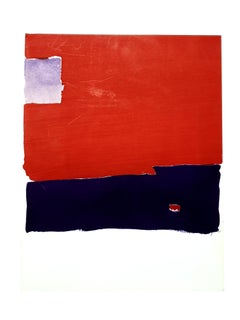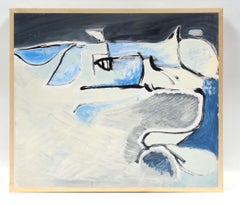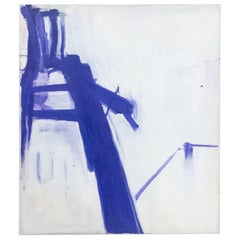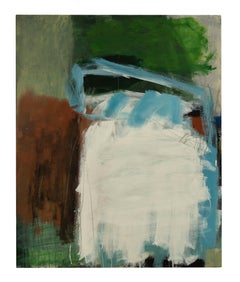Items Similar to de Staël, Coln d'atelier, fond bleu, Peintres d'aujourd'hui (after)
Want more images or videos?
Request additional images or videos from the seller
1 of 12
de Staël, Coln d'atelier, fond bleu, Peintres d'aujourd'hui (after)1960
1960
$716
$89520% Off
£542.69
£678.3620% Off
€628.21
€785.2720% Off
CA$1,010.81
CA$1,263.5120% Off
A$1,125.61
A$1,407.0220% Off
CHF 587.71
CHF 734.6420% Off
MX$13,638.89
MX$17,048.6120% Off
NOK 7,411.62
NOK 9,264.5320% Off
SEK 6,993.45
SEK 8,741.8120% Off
DKK 4,689.54
DKK 5,861.9220% Off
About the Item
Héliogravure on vélin paper. Paper Size: 13.78 x 10.83 inches. Inscription: Unsigned and unnumbered, as issued. Notes: From the folio, Nicolas de Staël, Peintres d'aujourd'hui, 1960. Published by Fernand Hazan, Éditeur, Paris; rendered by Bussière et Nouël, Paris; printed by l'Imprimerie Lecot, Paris, May 1960. Excerpted from the folio (translated from French), CCCLXXV examples of this album, numbered from I to CCCLXXV, are accompanied by an unpublished board illustrating a glued paper of the artist and shot on the presses of Daniel Jacomet, in Paris. The illustrations of this album, completed in May 1960, were shot by Bussière and Nouël and printed by the l'Imprimerie Lecot. The text was drawn by l'Imprimerie Damien and the binding made by F.l.A.P. according to the models of Marcel Jacno. Fernand Hazan Éditeur, 35-37, rue de Seine, Paris. 1960. Droits de reproduction réservés A.D.A.G.P. - Paris.
NICOLAS DE STAEL (1914-1955) was a French painter of Russian origin known for his use of a thick impasto and his highly abstract landscape painting. He also worked with collage, illustration and textiles. Known for his abstract landscapes and still lifes that uniquely blend colour, form and texture, Nicolas de Staël was fascinated by the world’s many spectacles and documented them through his art. De Staël was born in 1914 into an aristocratic family in Saint Petersburg, Russia. His father served as a cavalry general under Tsar Nicholas II and the family was forced to flee after the Russian Revolution. Both Nicolas’s parents died in the early 1920s, meaning he and his siblings were raised by a foster family in Brussels where he would begin his formal art education at the Académie Royale des Beaux-Arts. De Staël’s early work was influenced by the European avant-garde movements of the early 20th century, including Cubism and Fauvism. However, he soon developed his own distinctive style with thick impasto and a bold use of colour. His early paintings, often sombre in tone, gradually evolved into more vibrant and dynamic compositions, reflecting his growing interest in the emotional and expressive potential of colour and form. In 1938 de Staël had moved to France, where he became an integral part of the post-war Parisian art scene. Having worked initially in the atelier of Fernand Léger, de Staël’s circle of friends came to include Sonia Delaunay, Le Corbusier and Jean Arp, who encouraged his tendencies towards abstract work. His work during this period marked a significant departure from traditional representation, moving towards abstraction while maintaining a strong sense of structure and form. De Staël's paintings from this era showcase his ability to balance abstraction with figuration, using broad, gestural strokes and a vibrant palette to convey movement and energy. What truly set de Staël apart, though, was the step he took beyond abstraction. This came with his football paintings, which marked a small but hugely significant move towards representation. His work Parc des Princes (Les grands footballeurs) (1952), which captured the spectacle of the 1952 international football friendly between France and Sweden, epitomises his ability to transpose real-life dynamism onto canvas using his palette knife. In March 1953, de Staël travelled to New York to hang his debut American solo exhibition. Three months later, de Staël accepted an offer from the New York-based Paul Rosenberg to become his exclusive dealer in the United States. Rosenberg would show de Staël’s works in his gallery alongside those of Pablo Picasso, Georges Braque and Henri Matisse. Despite his success, de Staël’s life was marked by personal struggles, estrangement from his family and a sense of existential angst. His intense dedication to his art, combined with his perfectionist tendencies, often left him dissatisfied with his work. Tragically, in 1955, at the age of 41, de Staël took his own life. His death marked the end of a brilliant but brief career that left an indelible mark on 20th-century art. In 2019, Nicolas de Staël’s painting, Parc des Princes (Les grands footballeurs), sold for $22 million USD at Christie's Paris, setting a world record for the artist.
- Creation Year:1960
- Dimensions:Height: 13.78 in (35.01 cm)Width: 10.83 in (27.51 cm)
- Medium:
- Movement & Style:
- After:Nicolas de Staël (1914 - 1955, French)
- Period:
- Condition:
- Gallery Location:Southampton, NY
- Reference Number:1stDibs: LU1465216624182
About the Seller
4.9
Platinum Seller
Premium sellers with a 4.7+ rating and 24-hour response times
Established in 1978
1stDibs seller since 2021
1,173 sales on 1stDibs
Typical response time: <1 hour
- ShippingRetrieving quote...Shipping from: Southampton, NY
- Return Policy
Authenticity Guarantee
In the unlikely event there’s an issue with an item’s authenticity, contact us within 1 year for a full refund. DetailsMoney-Back Guarantee
If your item is not as described, is damaged in transit, or does not arrive, contact us within 7 days for a full refund. Details24-Hour Cancellation
You have a 24-hour grace period in which to reconsider your purchase, with no questions asked.Vetted Professional Sellers
Our world-class sellers must adhere to strict standards for service and quality, maintaining the integrity of our listings.Price-Match Guarantee
If you find that a seller listed the same item for a lower price elsewhere, we’ll match it.Trusted Global Delivery
Our best-in-class carrier network provides specialized shipping options worldwide, including custom delivery.More From This Seller
View Allde Staël, Pere des Princes, Nicolas de Staël, Peintres d'aujourd'hui (after)
By Nicolas de Staël
Located in Southampton, NY
Héliogravure on vélin paper. Paper Size: 13.78 x 10.83 inches. Inscription: Signed in the plate and unnumbered, as issued. Notes: From the folio, Nicolas de Staël, Peintres d'aujourd'hui, 1960. Published by Fernand Hazan, Éditeur, Paris; rendered by Bussière et Nouël, Paris; printed by l'Imprimerie Lecot, Paris, May 1960. Excerpted from the folio (translated from French), CCCLXXV examples of this album, numbered from I to CCCLXXV, are accompanied by an unpublished board illustrating a glued paper of the artist and shot on the presses of Daniel Jacomet, in Paris. The illustrations of this album, completed in May 1960, were shot by Bussière and Nouël and printed by the l'Imprimerie Lecot. The text was drawn by l'Imprimerie Damien and the binding made by F.l.A.P. according to the models of Marcel Jacno. Fernand Hazan Éditeur, 35-37, rue de Seine, Paris. 1960. Droits de reproduction réservés A.D.A.G.P. - Paris.
NICOLAS DE STAEL (1914-1955) was a French painter of Russian origin known for his use of a thick impasto and his highly abstract landscape painting. He also worked with collage, illustration and textiles. Known for his abstract landscapes and still lifes that uniquely blend colour, form and texture, Nicolas de Staël was fascinated by the world’s many spectacles and documented them through his art. De Staël was born in 1914 into an aristocratic family in Saint Petersburg, Russia. His father served as a cavalry general under Tsar Nicholas II and the family was forced to flee after the Russian Revolution. Both Nicolas’s parents died in the early 1920s, meaning he and his siblings were raised by a foster family in Brussels where he would begin his formal art education at the Académie Royale des Beaux-Arts. De Staël’s early work was influenced by the European avant-garde movements of the early 20th century, including Cubism and Fauvism. However, he soon developed his own distinctive style with thick impasto and a bold use of colour. His early paintings, often sombre in tone, gradually evolved into more vibrant and dynamic compositions, reflecting his growing interest in the emotional and expressive potential of colour and form. In 1938 de Staël had moved to France, where he became an integral part of the post-war Parisian art scene. Having worked initially in the atelier of Fernand Léger, de Staël’s circle of friends came to include Sonia Delaunay, Le Corbusier and Jean Arp, who encouraged his tendencies towards abstract work. His work during this period marked a significant departure from traditional representation, moving towards abstraction while maintaining a strong sense of structure and form. De Staël's paintings from this era showcase his ability to balance abstraction with figuration, using broad, gestural strokes and a vibrant palette to convey movement and energy. What truly set de Staël apart, though, was the step he took beyond abstraction. This came with his football paintings...
Category
1960s Modern Abstract Prints
Materials
Lithograph
$716 Sale Price
20% Off
de Staël, Composition, Nicolas de Staël, Peintres d'aujourd'hui (after)
By Nicolas de Staël
Located in Southampton, NY
Héliogravure on vélin paper. Paper Size: 10.83 x 13.78 inches. Inscription: Signed in the plate and unnumbered, as issued. Notes: From the folio, Nicolas de Staël, Peintres d'aujourd...
Category
1960s Modern Abstract Prints
Materials
Lithograph
$716 Sale Price
20% Off
de Staël, Nu debout, Nicolas de Staël, Peintres d'aujourd'hui (after)
By Nicolas de Staël
Located in Southampton, NY
Héliogravure on vélin paper. Paper Size: 13.78 x 10.83 inches. Inscription: Unsigned and unnumbered, as issued. Notes: From the folio, Nicolas de Staël, Peintres d'aujourd'hui, 1960. Published by Fernand Hazan, Éditeur, Paris; rendered by Bussière et Nouël, Paris; printed by l'Imprimerie Lecot, Paris, May 1960. Excerpted from the folio (translated from French), CCCLXXV examples of this album, numbered from I to CCCLXXV, are accompanied by an unpublished board illustrating a glued paper of the artist and shot on the presses of Daniel Jacomet, in Paris. The illustrations of this album, completed in May 1960, were shot by Bussière and Nouël and printed by the l'Imprimerie Lecot. The text was drawn by l'Imprimerie Damien and the binding made by F.l.A.P. according to the models of Marcel Jacno. Fernand Hazan Éditeur, 35-37, rue de Seine, Paris. 1960. Droits de reproduction réservés A.D.A.G.P. - Paris.
NICOLAS DE STAEL (1914-1955) was a French painter of Russian origin known for his use of a thick impasto and his highly abstract landscape painting. He also worked with collage, illustration and textiles. Known for his abstract landscapes and still lifes that uniquely blend colour, form and texture, Nicolas de Staël was fascinated by the world’s many spectacles and documented them through his art. De Staël was born in 1914 into an aristocratic family in Saint Petersburg, Russia. His father served as a cavalry general under Tsar Nicholas II and the family was forced to flee after the Russian Revolution. Both Nicolas’s parents died in the early 1920s, meaning he and his siblings were raised by a foster family in Brussels where he would begin his formal art education at the Académie Royale des Beaux-Arts. De Staël’s early work was influenced by the European avant-garde movements of the early 20th century, including Cubism and Fauvism. However, he soon developed his own distinctive style with thick impasto and a bold use of colour. His early paintings, often sombre in tone, gradually evolved into more vibrant and dynamic compositions, reflecting his growing interest in the emotional and expressive potential of colour and form. In 1938 de Staël had moved to France, where he became an integral part of the post-war Parisian art scene. Having worked initially in the atelier of Fernand Léger, de Staël’s circle of friends came to include Sonia Delaunay, Le Corbusier and Jean Arp, who encouraged his tendencies towards abstract work. His work during this period marked a significant departure from traditional representation, moving towards abstraction while maintaining a strong sense of structure and form. De Staël's paintings from this era showcase his ability to balance abstraction with figuration, using broad, gestural strokes and a vibrant palette to convey movement and energy. What truly set de Staël apart, though, was the step he took beyond abstraction. This came with his football paintings...
Category
1960s Modern Abstract Prints
Materials
Lithograph
$716 Sale Price
20% Off
de Staël, Sans titre, Nicolas de Staël, Peintres d'aujourd'hui (after)
By Nicolas de Staël
Located in Southampton, NY
Héliogravure on vélin paper. Paper Size: 13.78 x 10.83 inches. Inscription: Unsigned and unnumbered, as issued. Notes: From the folio, Nicolas de Staël, Peintres d'aujourd'hui, 1960. Published by Fernand Hazan, Éditeur, Paris; rendered by Bussière et Nouël, Paris; printed by l'Imprimerie Lecot, Paris, May 1960. Excerpted from the folio (translated from French), CCCLXXV examples of this album, numbered from I to CCCLXXV, are accompanied by an unpublished board illustrating a glued paper of the artist and shot on the presses of Daniel Jacomet, in Paris. The illustrations of this album, completed in May 1960, were shot by Bussière and Nouël and printed by the l'Imprimerie Lecot. The text was drawn by l'Imprimerie Damien and the binding made by F.l.A.P. according to the models of Marcel Jacno. Fernand Hazan Éditeur, 35-37, rue de Seine, Paris. 1960. Droits de reproduction réservés A.D.A.G.P. - Paris.
NICOLAS DE STAEL (1914-1955) was a French painter of Russian origin known for his use of a thick impasto and his highly abstract landscape painting. He also worked with collage, illustration and textiles. Known for his abstract landscapes and still lifes that uniquely blend colour, form and texture, Nicolas de Staël was fascinated by the world’s many spectacles and documented them through his art. De Staël was born in 1914 into an aristocratic family in Saint Petersburg, Russia. His father served as a cavalry general under Tsar Nicholas II and the family was forced to flee after the Russian Revolution. Both Nicolas’s parents died in the early 1920s, meaning he and his siblings were raised by a foster family in Brussels where he would begin his formal art education at the Académie Royale des Beaux-Arts. De Staël’s early work was influenced by the European avant-garde movements of the early 20th century, including Cubism and Fauvism. However, he soon developed his own distinctive style with thick impasto and a bold use of colour. His early paintings, often sombre in tone, gradually evolved into more vibrant and dynamic compositions, reflecting his growing interest in the emotional and expressive potential of colour and form. In 1938 de Staël had moved to France, where he became an integral part of the post-war Parisian art scene. Having worked initially in the atelier of Fernand Léger, de Staël’s circle of friends came to include Sonia Delaunay, Le Corbusier and Jean Arp, who encouraged his tendencies towards abstract work. His work during this period marked a significant departure from traditional representation, moving towards abstraction while maintaining a strong sense of structure and form. De Staël's paintings from this era showcase his ability to balance abstraction with figuration, using broad, gestural strokes and a vibrant palette to convey movement and energy. What truly set de Staël apart, though, was the step he took beyond abstraction. This came with his football paintings...
Category
1960s Modern Abstract Prints
Materials
Lithograph
$716 Sale Price
20% Off
de Staël, Bouteilles, Nicolas de Staël, Peintres d'aujourd'hui (after)
By Nicolas de Staël
Located in Southampton, NY
Héliogravure on vélin paper. Paper Size: 13.78 x 10.83 inches. Inscription: Signed in the plate and unnumbered, as issued. Notes: From the folio, Nicolas de Staël, Peintres d'aujourd'hui, 1960. Published by Fernand Hazan, Éditeur, Paris; rendered by Bussière et Nouël, Paris; printed by l'Imprimerie Lecot, Paris, May 1960. Excerpted from the folio (translated from French), CCCLXXV examples of this album, numbered from I to CCCLXXV, are accompanied by an unpublished board illustrating a glued paper of the artist and shot on the presses of Daniel Jacomet, in Paris. The illustrations of this album, completed in May 1960, were shot by Bussière and Nouël and printed by the l'Imprimerie Lecot. The text was drawn by l'Imprimerie Damien and the binding made by F.l.A.P. according to the models of Marcel Jacno. Fernand Hazan Éditeur, 35-37, rue de Seine, Paris. 1960. Droits de reproduction réservés A.D.A.G.P. - Paris.
NICOLAS DE STAEL (1914-1955) was a French painter of Russian origin known for his use of a thick impasto and his highly abstract landscape painting. He also worked with collage, illustration and textiles. Known for his abstract landscapes and still lifes that uniquely blend colour, form and texture, Nicolas de Staël was fascinated by the world’s many spectacles and documented them through his art. De Staël was born in 1914 into an aristocratic family in Saint Petersburg, Russia. His father served as a cavalry general under Tsar Nicholas II and the family was forced to flee after the Russian Revolution. Both Nicolas’s parents died in the early 1920s, meaning he and his siblings were raised by a foster family in Brussels where he would begin his formal art education at the Académie Royale des Beaux-Arts. De Staël’s early work was influenced by the European avant-garde movements of the early 20th century, including Cubism and Fauvism. However, he soon developed his own distinctive style with thick impasto and a bold use of colour. His early paintings, often sombre in tone, gradually evolved into more vibrant and dynamic compositions, reflecting his growing interest in the emotional and expressive potential of colour and form. In 1938 de Staël had moved to France, where he became an integral part of the post-war Parisian art scene. Having worked initially in the atelier of Fernand Léger, de Staël’s circle of friends came to include Sonia Delaunay, Le Corbusier and Jean Arp, who encouraged his tendencies towards abstract work. His work during this period marked a significant departure from traditional representation, moving towards abstraction while maintaining a strong sense of structure and form. De Staël's paintings from this era showcase his ability to balance abstraction with figuration, using broad, gestural strokes and a vibrant palette to convey movement and energy. What truly set de Staël apart, though, was the step he took beyond abstraction. This came with his football paintings...
Category
1960s Modern Abstract Prints
Materials
Lithograph
$716 Sale Price
20% Off
de Staël, Sans titre, Société internationale d'art XXe siècle (after)
By Nicolas de Staël
Located in Southampton, NY
Lithograph on vélin paper. Paper Size: 12.4 x 9.65 inches. Inscription: Unsigned and unnumbered, as issued. Notes: From the album, XXe siècle, Nouvelle série, XXIe Année, N°12 Mal-Ju...
Category
1950s Modern Abstract Prints
Materials
Lithograph
$2,396 Sale Price
20% Off
You May Also Like
(after) Nicolas de Staël - Abstract Composition - Pochoir
By Nicolas de Staël
Located in Collonge Bellerive, Geneve, CH
(after) Nicolas de Staël - Abstract Composition - Pochoir
Published in the deluxe art review, XXe Siecle
1959
Dimensions: 32 x 24 cm
Publisher: G. d...
Category
1950s Abstract Expressionist Abstract Prints
Materials
Stencil
Abstract Expressionist Painting American Late 1960's Mid Century New York Blue
Located in Buffalo, NY
Mid Century Modern, American Abstract Expressionist Painting on Masonite.
This wonderful work in hues of blue comes house in a contemporary natural wood frame presentation..
The ar...
Category
1960s Abstract Expressionist Abstract Paintings
Materials
Acrylic, Masonite
Copy of Abstract Expressionist Blue Painting
Located in Queens, NY
Copy of an Abstract Expressionist style painting showing strong blue brushstrokes on white ground
Condition: Good; Wear consistent with age and use
Category
Late 20th Century American Modern Paintings
Materials
Paint
Swiss Abstract Contemporary Art by Pierre-Alain Michel - Au Bord du Doubs
Located in Paris, IDF
Acrylic on canvas
Pierre-Alain Michel is a Swiss painter born in 1959 who lives & works in Delémont in Switzerland. In 1989 he was enrolled at the School of Fine Arts in Basel and f...
Category
2010s Abstract Abstract Paintings
Materials
Canvas, Acrylic
Composition bleu.
By James Coignard
Located in Malmo, SE
Frame in wood white gold.
Free shipment worldwide.
Acquired directly from the artist.
Size without frame: 71 x 51 cm (Size with frame 77 x 58 cm)
“With just a few strokes of his b...
Category
1990s Abstract Abstract Paintings
Materials
Paper, Oil
Blue Still Life
Located in Wiscasset, ME
This vibrant work by noted 20th century American artist, Joel Durand, employs a bold palette and sophisticated approach in this dramatic and abstracted sti...
Category
1950s Modern Abstract Paintings
Materials
Oil, Board
